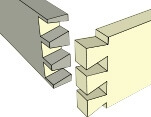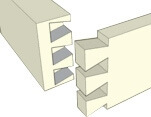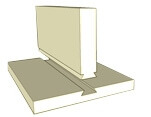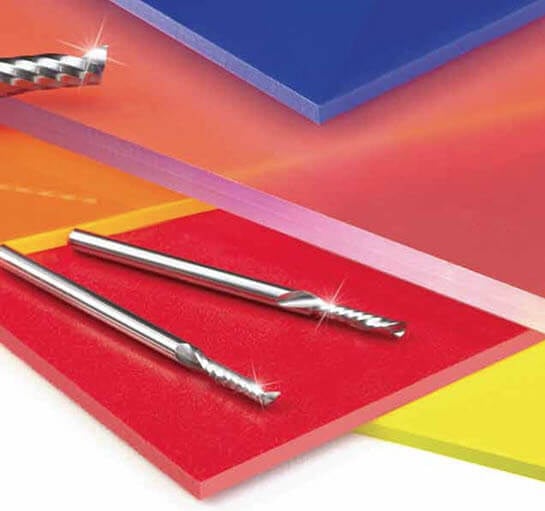
Dovetail Joints: 5 Different Types and Their Uses
Dovetail joints are a sign of a true craftsman. Noted for their resilience to pull apart, these finger-like joints between two pieces of wood enable a tight, strong, and long lasting fit. Dovetail joints require zero mechanical fasteners, making them more attractive to the traditionalist.
There are two parts to a dovetail joint: pins and tails. The tails look like the tail of a dove (hence the name), and the pins are on the opposite board and fit in between the tails to create a joint that is impossible to pull apart in at least one direction. Add some glue, clamp the joint together well, and it will be impossible to pull apart in the other direction as well.
The evidence of this joint lasting the test of time is found in any antique shop. If one were to step into an antique furniture shop, one could pull out drawers and most likely see an overwhelming majority constructed with the dovetail joint - a sure sign of quality.
Advantages of Dovetail Joints
The advantages of the dovetail joint are that it is the strongest of all joints, has a large gluing area, is interlocking, resists being pulled apart, looks attractive, and would hold together even without glue.
Disadvantages of Dovetail Joints
The disadvantages of dovetail joints are that they can be fairly difficult to mark out and cut, and if they are made badly these joints lose the advantages listed above.
Depending on the project, function, and design, there are a number of different types of dovetail joints to choose from. Creating the correct type for your project will enable you to not only create strength but highlight your skills and abilities as well.
5 Types of Dovetail Joints
The following are the different types of dovetail joints:
- Through dovetail
- Half-blind dovetail
- Secret mitered dovetail
- Sliding dovetail
- Full-blind dovetail

Through Dovetail ^
The most basic method of creating a dovetail is called a through dovetail. Here, two pieces of wood are joined together at their ends with a finger-like interlocking method which is seen from all outside surfaces. This method is used in everyday practice for joining the corners of frames, boxes, cabinets, and other items.

Half-Blind Dovetail ^
A half-blind dovetail enables the woodworker to hide the joint from the front end. The tails are housed in sockets in the ends of the board that is to be the front of the item so that their ends cannot be seen.
Half-blind dovetails are commonly used to fasten drawer fronts to drawer sides. This is an alternative to the practice of attaching false fronts to drawers constructed using through dovetails.

Secret Mitered Dovetail ^
The secret mitered dovetail joint (also called a mitered blind dovetail) is used in the highest class of cabinet and box work. It offers the strength found in the dovetail joint but is totally hidden from both the inside and outside corners by forming the outer edge to meet at a 45-degree angle while hiding the dovetails internally within the joint.
The mitered corner dovetail joint is very similar in design, but it has just a single dovetail and is used for picture frames and other similar joints.

Sliding Dovetail ^
The sliding dovetail is a method of joining two boards at right angles, where the intersection occurs within the field of one of the boards that is not at the end. This joint provides the interlocking strength of a dovetail. Sliding dovetails are assembled by sliding the tail into the socket. It is common to slightly taper the socket, making it slightly tighter towards the rear of the joint, so that the two components can be slid together easily but the joint becomes tighter as the finished position is reached.
Deciding which type of dovetail to choose for your project is dependent on factors such as function and design. With technology advances as they are today, woodworking on a high level has become much more accessible. Creating dovetails by hand is a master skill in of itself. But, we are now able to use jigs, routers and specialized dovetail bits to ensure that the joint can be made perfectly and replicated an endless amount of times. So, when creating special projects you wish to last generations, you can be sure that dovetails will help ensure they will be long lasting.
Frequently Asked Questions:
- What is the difference between a through dovetail and a half-blind dovetail joint?
A through dovetail joint is visible from all sides and often used in box and frame construction. A half-blind dovetail hides the joint from the front, making it ideal for attaching drawer fronts where a cleaner exterior look is desired. - Are dovetail joints the strongest type of wood joint?
Yes, dovetail joints are widely considered the strongest woodworking joints due to their interlocking design and large glue surface. Properly made, they resist pulling apart even without glue. - Are dovetail joints hard to make?
They can be challenging to cut by hand, requiring precision and skill. However, jigs and dovetail router bits (https://toolstoday.com/router-bits/dovetail-router-bits.html) make it much easier to create clean, repeatable dovetail joints—even for beginners. - What are the disadvantages of dovetail joints?
Dovetail joints can be time-consuming and difficult to cut accurately without the right tools. If not made well, the joint can lose its strength and aesthetic appeal.
Learn more about 17 (Other) Types of Woodworking Joints
Dovetail Videos:
Watch Dovetail Router Bits on the CNC full-screen.
Watch CNC Project: Using Dovetails on the CNC Router to Build a Shaker Style Dresser full-screen.





